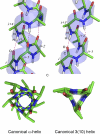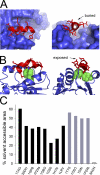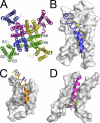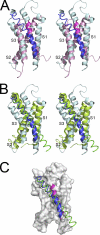3(10) helices in channels and other membrane proteins
- PMID: 21115694
- PMCID: PMC2995148
- DOI: 10.1085/jgp.201010508
3(10) helices in channels and other membrane proteins
Figures





Similar articles
-
Oligomeric structure, dynamics, and orientation of membrane proteins from solid-state NMR.Structure. 2006 Dec;14(12):1731-40. doi: 10.1016/j.str.2006.10.002. Structure. 2006. PMID: 17161364 Review.
-
Membrane simulations: bigger and better?Curr Opin Struct Biol. 2000 Apr;10(2):174-81. doi: 10.1016/s0959-440x(00)00066-x. Curr Opin Struct Biol. 2000. PMID: 10753807 Review.
-
A computational model of the HBK2 potassium channel ion pore.Biochem Biophys Res Commun. 1993 Aug 16;194(3):1117-23. doi: 10.1006/bbrc.1993.1937. Biochem Biophys Res Commun. 1993. PMID: 8352767
-
Proline-induced hinges in transmembrane helices: possible roles in ion channel gating.Proteins. 2001 Aug 1;44(2):63-72. doi: 10.1002/prot.1073. Proteins. 2001. PMID: 11391769
-
Membrane protein folding: beyond the two stage model.FEBS Lett. 2003 Nov 27;555(1):122-5. doi: 10.1016/s0014-5793(03)01106-2. FEBS Lett. 2003. PMID: 14630331 Review.
Cited by
-
Structural basis for ion selectivity in TMEM175 K+ channels.Elife. 2020 Apr 8;9:e53683. doi: 10.7554/eLife.53683. Elife. 2020. PMID: 32267231 Free PMC article.
-
Crystal structures of free and ligand-bound forms of the TetR/AcrR-like regulator SCO3201 from Streptomyces coelicolor suggest a novel allosteric mechanism.FEBS J. 2023 Jan;290(2):521-532. doi: 10.1111/febs.16606. Epub 2022 Sep 2. FEBS J. 2023. PMID: 36017630 Free PMC article.
-
Metal Bridge in S4 Segment Supports Helix Transition in Shaker Channel.Biophys J. 2020 Feb 25;118(4):922-933. doi: 10.1016/j.bpj.2019.08.035. Epub 2019 Sep 5. Biophys J. 2020. PMID: 31635788 Free PMC article.
-
The Role of Lipids in CRAC Channel Function.Biomolecules. 2022 Feb 23;12(3):352. doi: 10.3390/biom12030352. Biomolecules. 2022. PMID: 35327543 Free PMC article. Review.
-
A New Secondary Structure Assignment Algorithm Using Cα Backbone Fragments.Int J Mol Sci. 2016 Mar 11;17(3):333. doi: 10.3390/ijms17030333. Int J Mol Sci. 2016. PMID: 26978354 Free PMC article.
References
-
- Bellanda M., Mammi S., Geremia S., Demitri N., Randaccio L., Broxterman Q.B., Kaptein B., Pengo P., Pasquato L., Scrimin P. 2007. Solvent polarity controls the helical conformation of short peptides rich in Calpha-tetrasubstituted amino acids. Chemistry (Easton). 13:407–416 - PubMed
Publication types
MeSH terms
Substances
LinkOut - more resources
Full Text Sources

